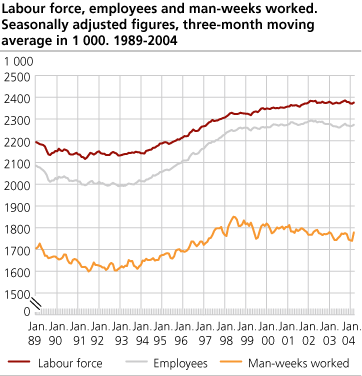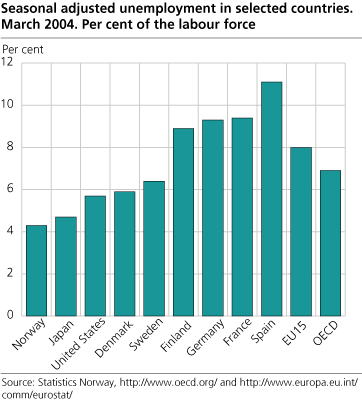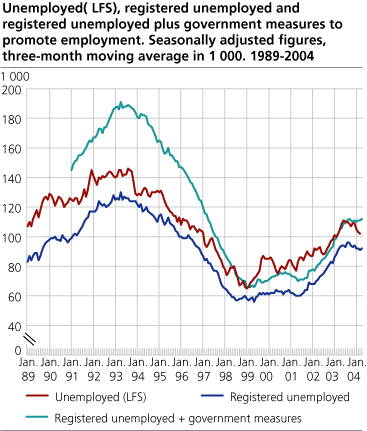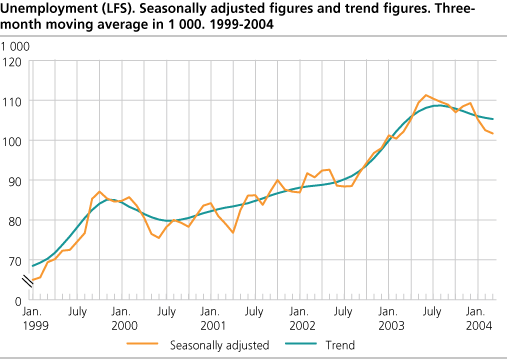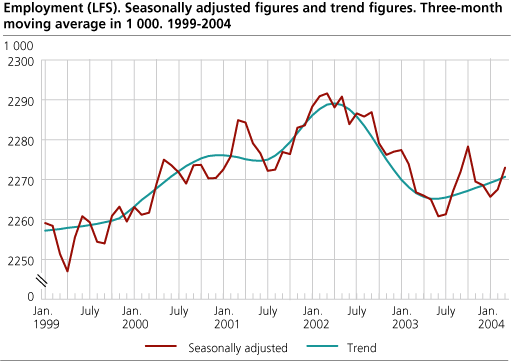Content
Published:
This is an archived release.
Employment on the rise
Since June last year the employment trend has been a weak increase, and the March figure strengthen this impression. The figures are adjusted for seasonal variations.
June 2003 saw an increase in employment after a longer period of decline. In March this year the number of employees increased by 5 000 from the previous month, which is inside the error margin.
The last figure for March (the February-April period) shows that unemployment decreased by 1 000 people from the previous month (January-March), which is inside the error margin. The development is still confirming the downward trend we have seen in unemployment since June (May-July) last year. Seasonally adjusted figures of registered unemployment at job centres showed the same development from February to March.
Unemployment up in Sweden
The seasonally adjusted unemployment rate for Norway was 4.3 per cent in March 2004, compared with 4.6 per cent in December 2003. Unemployment in the EU and OECD countries remained flat at 8.0 and 6.9 per cent respectively.
Also in the USA unemployment stayed unchanged at 5.7 per cent from December to March. Sweden experienced unemployment growth from 6.0 to 6.4 per cent, while the figure for Denmark went down from 6.0 to 5.9 per cent. In Finland unemployment remained unchanged at 8.9 per cent. This was more or less the case also in Germany and France, according to figures from the OECD and Eurostat .
Man-weeks worked have shown a downward trend since the summer of 1998. But from December 2003 to March 2004 man-weeks worked increased by 31 000, which is clearly outside the error margin. The increase must, however, be seen in association with an extra large amount of employees taking time off work around New Year's Day, which led to an extraordinary low level of man-weeks worked in December (the November-January period).
Uncertain figures
Quality tests show that the seasonally adjusted LFS unemployment figures are uncertain. The seasonal-adjustment method has problems identifying a stable seasonal pattern for this series. The random component is relatively large compared with the seasonal component. The figures should therefore be treated with caution.
The purpose of adjusting for seasonal variations is to describe the development during the last year and to provide figures of change between the last two three-month periods, cleared for normal seasonal variations. In order to reduce uncertainty, the presented series are three-month moving averages of the seasonally adjusted figures. For instance, the figures for March are the average of the estimates for February, March and April.
Tables:
The statistics is published with Labour force survey.
Contact
-
Arbeidsmarked og lønn
E-mail: arbeidsmarked@ssb.no
-
Erik Herstad Horgen
E-mail: erik.horgen@ssb.no
tel.: (+47) 93 08 68 62

